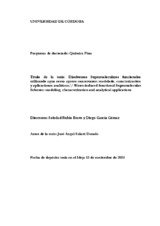Water-induced functional Supramolecular Solvents: modeling, characterization and analytical applications
Disolventes supramoleculares funcionales utilizando agua como agente coacervante: modelado, caracterización y aplicaciones analíticas
Autor
Salatti Dorado, José Ángel
Director/es
Rubio Bravo, SoledadGarcía-Gómez, Diego
Editor
Universidad de Córdoba, UCOPressFecha
2018Materia
Supramolecular solventsAnalytical extraction
Nanostructured lipid carriers
Coacervating agent
Water
Nanotechnology
Nanomaterials
Analytical Chemistry
METS:
Mostrar el registro METSPREMIS:
Mostrar el registro PREMISMetadatos
Mostrar el registro completo del ítemResumen
The content of this Doctoral Thesis has been structured in four chapters
preceded by a general Introduction in which the theoretical and practical aspects related
to the synthesis, modeling possibilities and application of supramolecular solvents
(SUPRAS) as well as the encapsulation of lipophilic bioactive substances in
nanostructured lipid carriers are discussed. Below, the content of each chapter is
described:
Chapter I: Volatile amphiphile-based supramolecular solvents for reducing
phospholipid-based matrix effects in LC-MS/MS
The research presented in this chapter has focused on the synthesis and
characterization of volatile SUPRAS with restricted access properties for the elimination
of matrix effects in the analysis of biological samples by LC-MS/MS. For this purpose, a
SUPRAS has been synthetized from hexanol in THF solutions by the addition of water
as coacervating agent. The phase diagram for this ternary mixture was constructed,
delimiting the SUPRAS region, and its composition was investigated according to the
environmental conditions established for the self-assembly of hexanol. The equation
predicting the volume of SUPRAS formed as a function of environmental conditions
was established. As in the case of other alkanols, hexanol aggregates in the SUPRAS as
inverse hexagonal structures in which the alcohol groups surround aqueous cavities
while the hydrocarbon chains are dispersed in THF.
The ability of the SUPRAS synthesized for the removal of matrix effects in
bioanalysis was investigated by the determination of bisphenol A (BPA) in urine. The insitu
formation of SUPRAS in this matrix and the removal of proteins and phospholipids
were investigated. It was demonstrated that supramolecular extracts can be analyzed
directly by LC-MS/MS avoiding matrix effects, which allowed the quantification of
BPA via external calibration. BPA was quantitatively extracted in the SUPRAS
(recoveries in the 96-107% range). The limit of quantification of the method for BPA
was 0.025 ng/mL. The method was applied to the quantification of BPA in urine
samples. Chapter II: Supramolecular solvents formed by oligomeric surfactants to reduce
surfactant losses in the equilibrium solution
The research carried out in this chapter has focused on the synthesis and
characterization of SUPRAS obtained from solutions of poly-undecylenic acid (an
oligomeric surfactant) in THF or ethanol, using water as coacervating agent. A
comparative study of both ternary mixtures has been performed in terms of phase
diagrams, the chemical composition of SUPRAS generated from different
environmental conditions, the volume of SUPRAS formed and structural characteristics.
Different equations have been derived, generated as a function of the composition of
the synthetical solution, for predicting the volume and chemical composition of these
SUPRAS. The hypothesis of the oligomer being completely incorporated into the
SUPRAS was fully demonstrated. This property will make possible the application of
this novel SUPRAS to wastewater treatment and to the analysis of pollutants when the
use of high volumes of water is required.
Chapter III: High thermally stable supramolecular solvents applicable to
headspace gas chromatography
The research described in this chapter is focused on the synthesis of SUPRAS
from solutions of the oligomer poly-undecylenic acid in tetraglyme via the addition of
water as coacervating agent. The phase diagram from this ternary mixture was
constructed, delimiting the SUPRAS formation region, that was also characterized in
terms of chemical composition and physical properties such as thermal stability.
The applicability of these SUPRAS in headspace gas chromatography (HS-GC)
was investigated by the direct analysis of the extracts obtained from the extraction of
residual solvents in pharmaceutical products. The methodology developed allowed the
quantitative extraction of the different legislated classes of residual solvents (37 solvents
belonging to classes 1, 2A, 2B and 2C) and their determination by HS-GC-MS. The
determination of the 2C class solvents by previously described procedures is very
complex due to their high boiling points. It was demonstrated that the method can be
applied to a wide variety of pharmaceutical products. The method was also validated
according to the criteria established in the relevant legislation [ICH Q2 R1]. Chapter IV: Multifunctional supramolecular solvents for the combination of the
extraction and encapsulation of lipophilic bioactive components
The research described in this chapter has been developed in the ―lnstitut
National de la Santé et de la Recherche Médicale Unit 1148" in Paris, during the stay of
the PhD student in this center. This research has aimed at the combination of SUPRAS
and nanostructured lipid carriers (NLCs) for the effective extraction, stabilization and
encapsulation of lipophilic bioactive compounds. For this purpose, SUPRAS previously
described by the SAC research group for the extraction of astaxanthin from
Haematococcus pluvialis and formed by octanoic acid in ethanol-water have been used. In
previous research, the SAC group has demonstrated that these SUPRAS with restricted
access properties quantitatively extract astaxanthin and are able to produce oleoresins
that show the same composition as those obtained by extraction with supercritical fluids
(SFE), but at a much lower cost. The oleoresins thus obtained were used as the liquid
lipid fraction to get SUPRAS-NLCs. The synthetized nanoparticles were characterized
by several different techniques: DLS, AFM and Cryo-SEM microscopy, indicating that
spherical particles with an approximate size of 100 nm were formed. Their antioxidant
activity was determined by ORAC and α-TEAC and its ability to inhibit ROS in vitro
was assessed by the DHE probe. The results showed that the SUPRAS-NLCs here
synthetized exhibit an exceptional stability (at least 6 months at 4ºC) when compared to
previous research.
This Report also includes a section in which the main conclusions derived from
the obtained results are discussed.
Finally, appendix A lists the scientific papers published in specialized international
journals derived for this Thesis and, appendix B, the contributions made to national and
international conferences.

